Overview
Funnel Charts in Metrics Explorer provide a granular understanding of what portion of users are completing each step of a journey you define through your product or service. These charts are useful for understanding user behavior, identifying bottlenecks, and helping you develop insight-driven product changes that help users convert through your product more successfully.Example Use Cases
- Conversion Analysis: Monitor the progression of users through stages like sign-up, adding to cart, and purchase completion.
- Identifying Drop-off Points: Pinpoint where users drop-off of a process, allowing targeting improvements at these points.
- Comparing User Segments: Observe how different user segments move through the funnel, highlighting variations in behavior based on demographics, user types, or other criteria.
- Product Optimization: Determine which features or steps effectively move users to the next stage, and which require improvements.
- Experiment Analysis: Understand the conversion rates before and after first exposure to an experiment.
Defining a User Funnel
Step 1: Add Steps to your Funnel
To define a funnel, select a series of a events that represent different parts of a product flow that you are interested in understanding. To do so:- Go to Metrics Explorer under Analytics in the Navigation Bar, and switch over to the Funnel Charts view.
- Add steps to your funnel using the ”+” icon. Optionally add filters to funnel steps to target specific event or user properties. For WHN, you would add steps directly from your Metric Source. For Statsig Cloud, you can leverage events or metrics for the steps.
- On the step in question click the ”…” button and select “Combine Events”.
- Select the an additional event to add.
- Add any desired filters to each of the events in the funnel step.
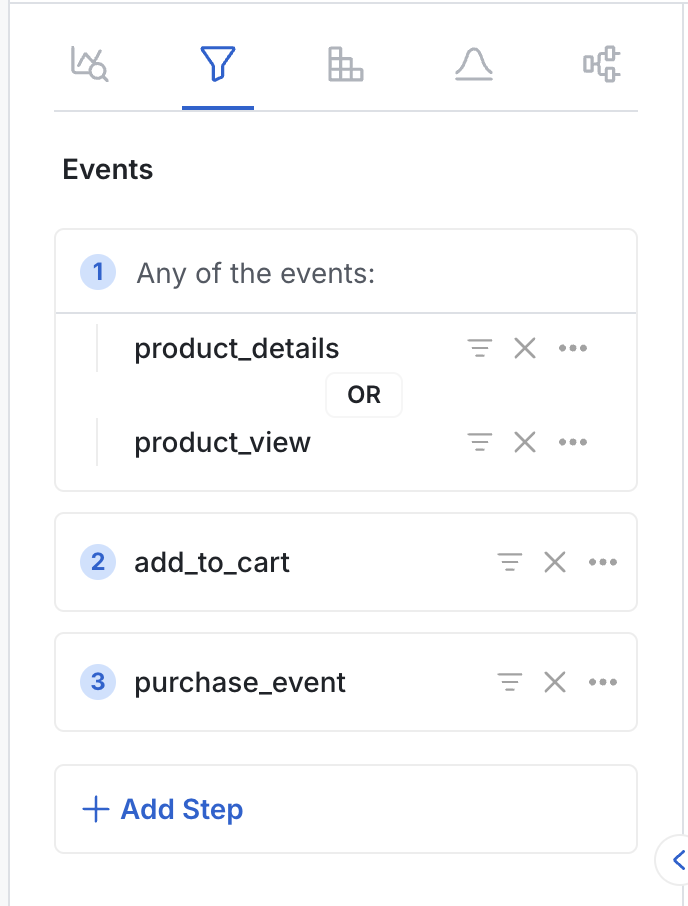
- Click ”…” next to the event in question.
- Select the “Filter to First Time”.
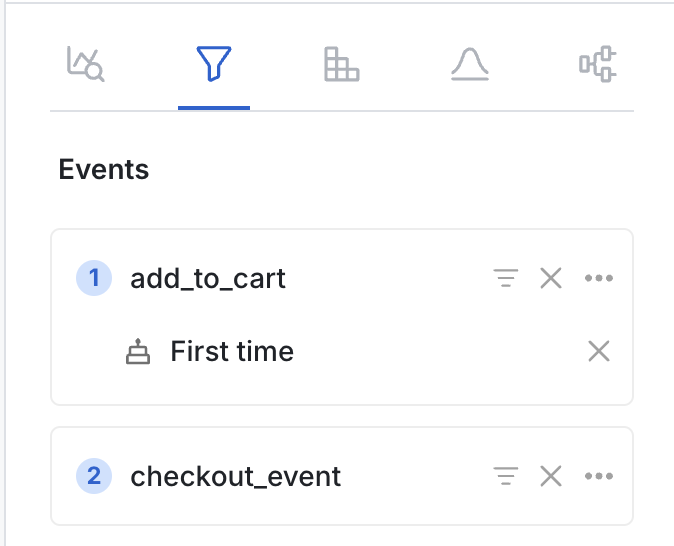
- Click the ”…” next to the event name you would like to rename.
- Click “Rename Funnel Step”.
- Give the funnel step a new easily readable name.
Step 2: Select a Graph Type
We support 3 graph types for understanding conversion funnels:- Conversion Rate: This is a standard funnel view that offers a step-by-step breakdown of where users are dropping off in your funnel, and the number of people converting through each step.
- Conversion Rate Over Time: This shows how the overall conversion rate of your funnel has changed over time. This is useful in understanding how new features and product changes have made an effected your funnel conversion rate.
- Time to Convert: This graph type helps you understand distributions in time it takes to complete your funnel.
Step 3: Choose an ID Type
In general, you want to construct funnels to understand the rate at which individual users make it through each step of the flow you’ve defined. This means creating a funnel using a userID. However, some interesting funnels may involve several people in an organization using your service. For example, you may want to understand the end-to-end success of company onboarding to your service, where different people are involved in purchasing, deploying, and then using your service. To this end, Statsig allows you to perform individual or group analytics. This enables you to analyze the success of your funnel at the user level, or the success of your funnel for whole groups such as organizations or companies. You can choose any of the ID types defined in your Statsig project to create a funnel over. If you have an experiment exposure selected, make sure that the ID type selected matches that of the experiment.Group analytics is not a paid add-on at Statsig and is included at no-extra cost for all tiers.
Step 4: Define the Conversion Window
Once you have defined your funnel, you can limit your analysis to Users (or other Unit IDs) that converted within a specified time frame. Users who start the funnel but do not convert within this time frame will be count as dropped off.Step 5: Drilldown
To better understand how conversion varies between different groups of users, you leverage the Group By feature to split out funnels by properties, experiment groups, or feature flag groups. To this, click the ”+” to the right of “Group By” and select the property, experiment, or feature flag you would like to split out the funnel conversion analysis by.Advanced Funnel Analysis
Ordered or Unordered Funnels
In general, the power of funnels lies in understanding whether or not users completed a specific set of events in a specific order. This is the most common scenario, and you can achieve this by toggling “Ordered” on. This is the default. Ordered funnels require that a user completes the selected events in the specified order to be counted as converted. The user may still perform other events between the specified events, including events in the funnel, and still be counted as converted. For example, if an ordered funnel is defined with events A, B, C, and D, the following sequence will count as converted: A→B→B→A→C→D. Sometimes, you just want to know whether a user has completed all a given set of events, regardless of the order they completed them in. You can achieve this by toggling “Ordered” off in the advanced settings. Unordered funnels only require that the user completes the specified events within the given time range to be counted as converted.Unique Users (or Unit ID) vs Total Conversions
You can choose whether your funnel analysis is defined by the total number of conversion that occur, or the number of unique users who convert. The default is Unique Users.Daily Aggregation
When toggled on, this calculates funnel conversions per calendar day. A given unit with funnel conversions on multiple days is counted as multiple conversions. This is toggled on by default.Interpreting your User Funnel
Conversion rate vs. Number of Conversions
At the top right of the funnel chart, you’ll see the Conversion Rate vs. Conversions selector. This selector allows you to switch between viewing the y-axis of your funnel as a conversion rate or the number of conversions. This feature is particularly powerful when used in conjunction with a group by. Toggling between conversion rate and number of conversions, you can see both the relative and absolute scales in conversions across different user groups.Conversion Summary and Table
Under each funnel step, you’ll see a quick summary that helps demystify your funnel data. Specifically, these metrics tell you:- The percentage and number of units that have converted relative to the first step of the funnel
- The percentage and number of units that have dropped off, again this number is relative to the first step of the funnel
- The average time it takes for each user to convert
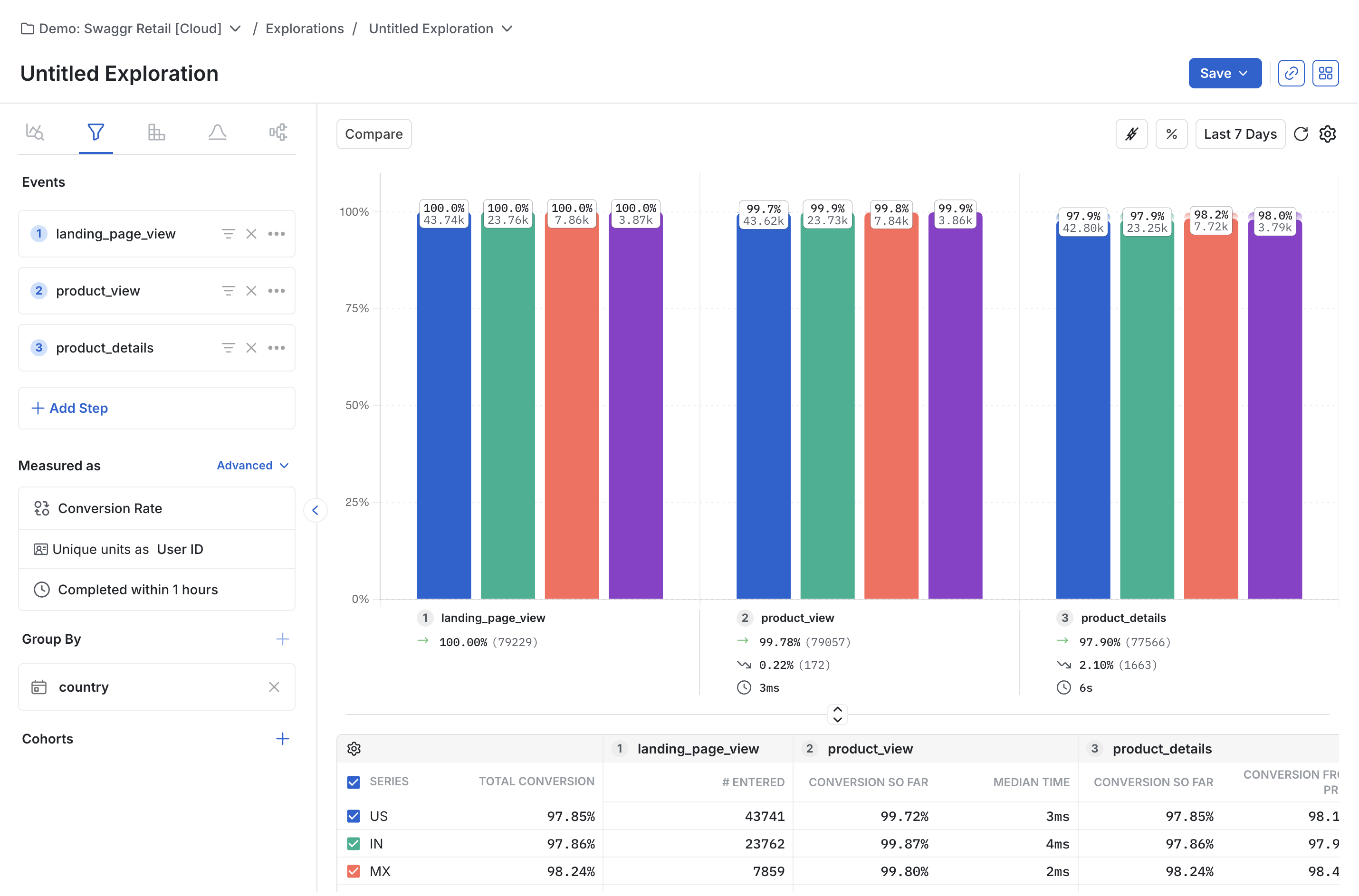
User Exploration
Finally, by clicking any bar in the funnel, you have the option to download all users in that segment who dropped off or converted as a CSV file. You also have the option to view session streams to get a granular, event-by-event understanding of a user’s experience before and after the data point in question.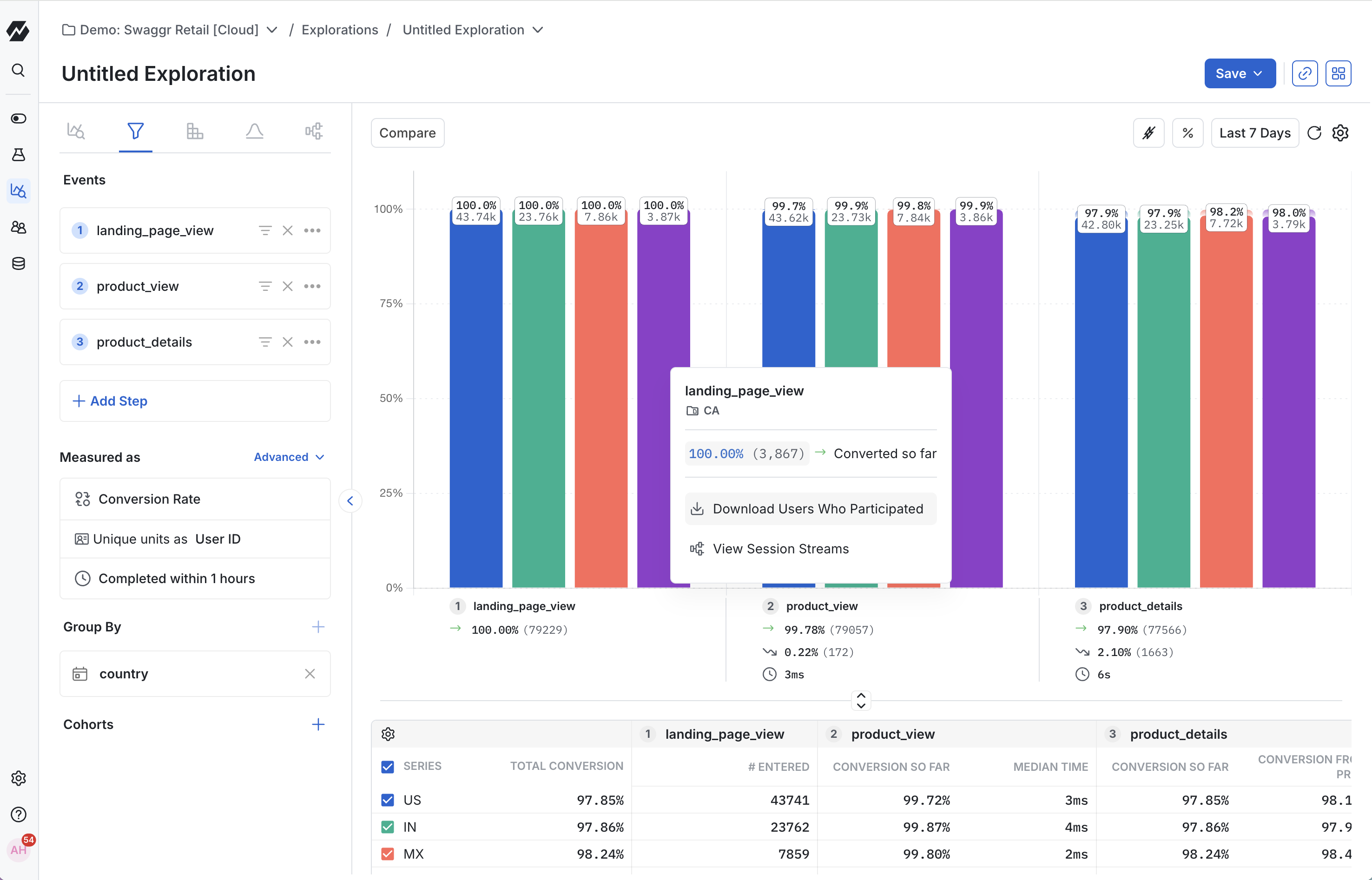
Conversion Drivers
Conversion Drivers identify statistically significant factors that correlate with funnel conversion or drop-off at each step. This analysis surfaces event properties, user properties, and intermediary events that influence user progression through your funnel.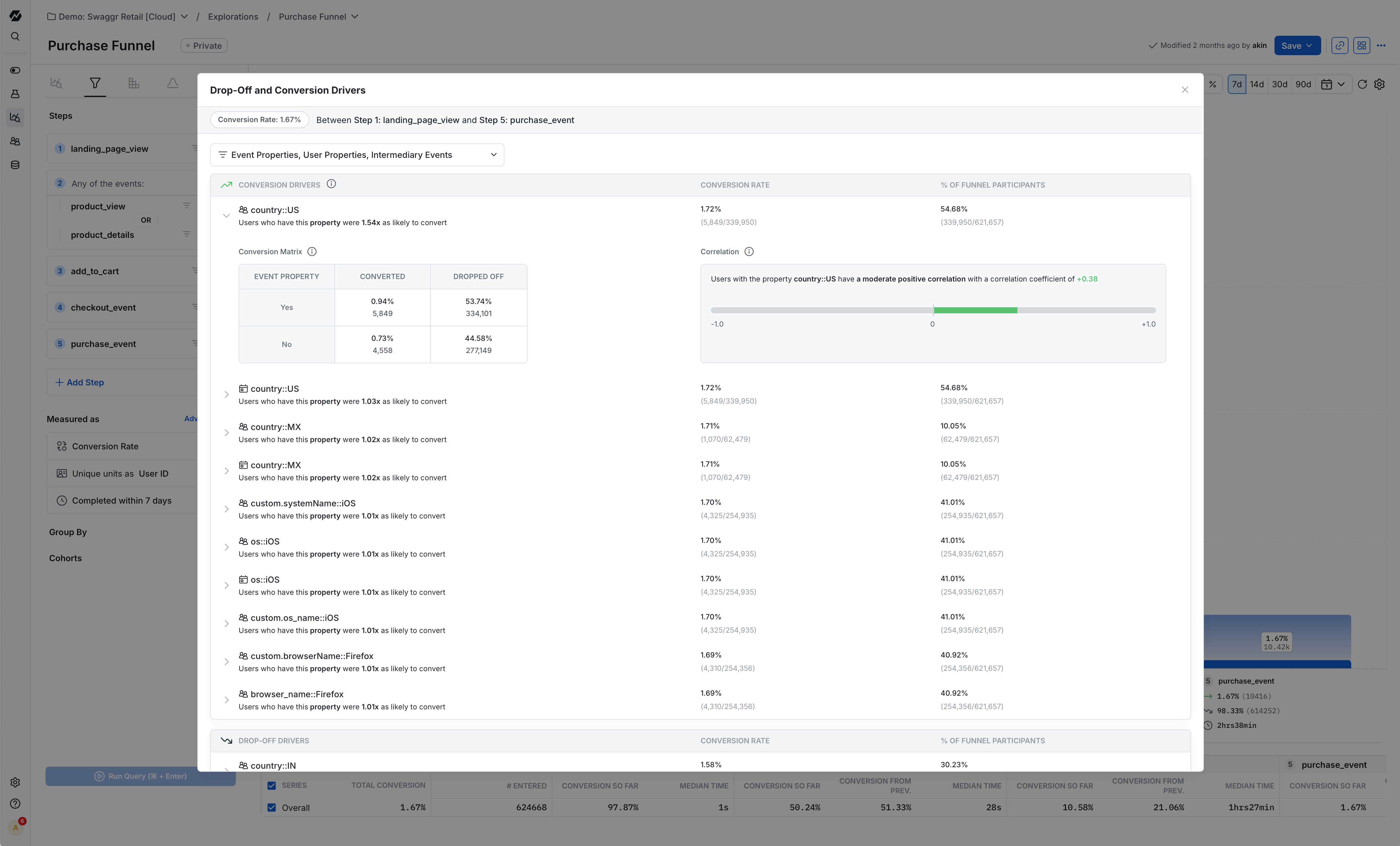
- Click on any funnel step
- Select “View Drop-Off & Conversion Drivers”
- Configure the analysis scope using the dropdown filters
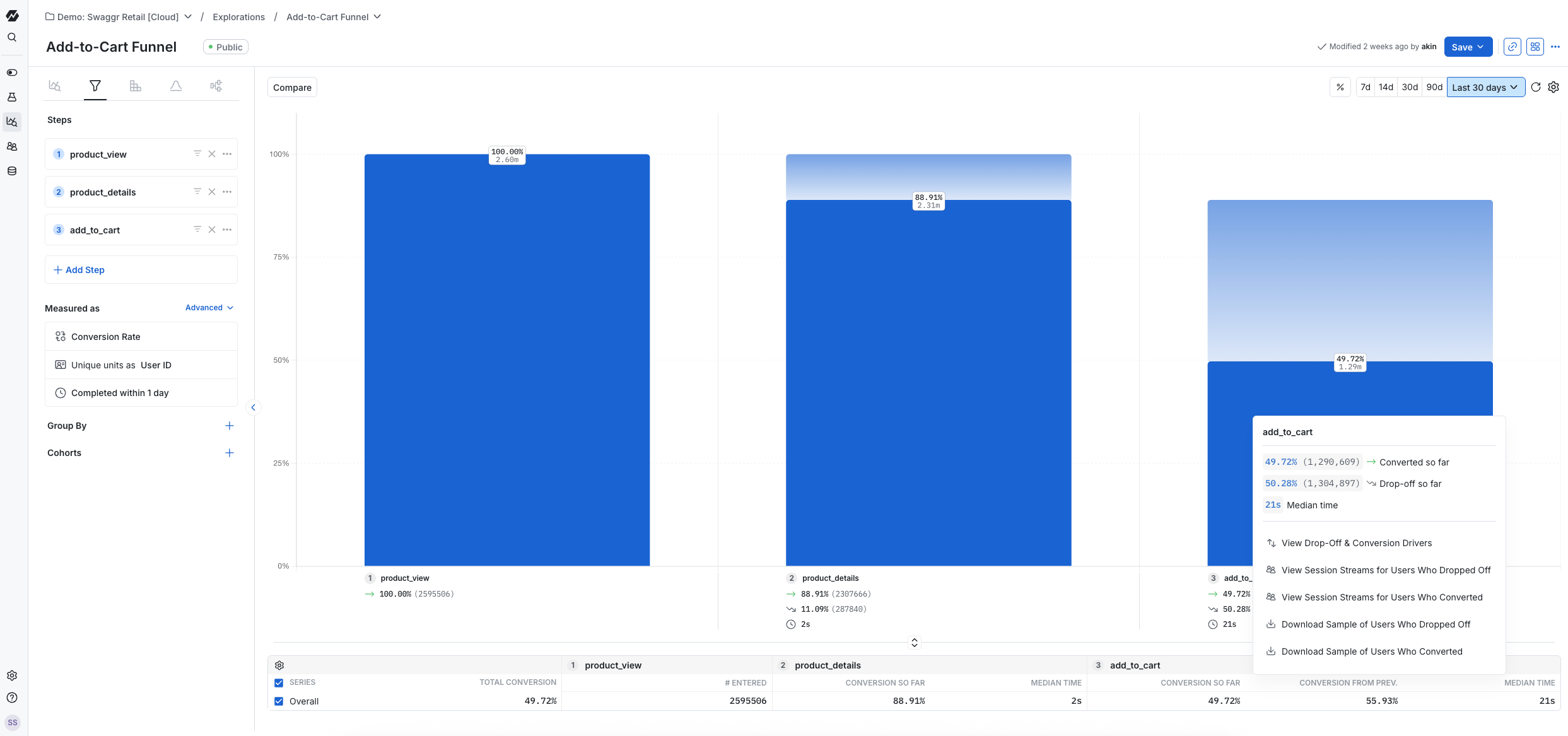
Analysis Configuration
You can configure which data types to include in the analysis:- Event Properties: Attributes attached to events (e.g., platform, plan_type, referral_code)
- User Properties: User-level attributes (e.g., country, account_age, signup_method)
- Intermediary Events: Events that occurred between the selected funnel steps
Driver Metrics
Each identified driver displays:- Conversion Likelihood: Expressed as a multiplier of the funnel’s conversion rate (e.g., users with platform::Android are 1.2x as likely to convert)
- Conversion Rate: Percentage of users with this factor who converted
- Participant Share: Percentage of total funnel participants who had this factor
Detailed Analysis
Click on any driver to access the drilldown view, which provides:- Conversion Matrix: Side-by-side comparison of conversion outcomes for users with and without the factor
- Correlation Coefficient: Statistical measure of the factor’s association with funnel completion (also known as the phi coefficient)
Use Cases
Conversion Drivers are useful for:- Exploratory analysis when investigating funnel performance without predefined hypotheses
- Root cause analysis of conversions/drop-offs
- Validating assumptions about user segment behavior
- Monitoring funnel performance changes over time
Conversion Drivers require a Pro plan subscription or Enterprise plan with the Advanced Analytics package.

